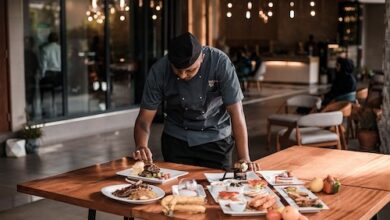
The Future of Food and Beverage in Hospitality: What to Expect in 2025
By Gavin Fraser | January 10, 2025
The food and beverage sector within hospitality is always evolving, responding to shifts in consumer behavior, technological advances, and broader trends. The industry is poised for even more dramatic changes, shaped by everything from environmental sustainability to digital innovation. How will emerging trends and innovations shape food and beverage offerings in hospitality, and how are businesses evolving to remain competitive in a rapidly changing market?
Sustainability Becomes Standard
Sustainability has already become a key theme in the hospitality industry, but this year it will likely be fully integrated into the core of food and beverage operations. Consumers are increasingly demanding eco-conscious options, and they are willing to pay a premium for food and drink that aligns with their environmental values. From sourcing ingredients locally to reducing food waste, sustainability is expected to influence everything from menu planning to packaging.
Expect to see more zero-waste practices in hospitality as restaurants and hotels adopt a “zero-waste” mindset. Food scraps will be repurposed for new dishes or composted to reduce landfill contributions. Plant-based ingredients and alternatives will become mainstream, catering not just to vegans but to the broader population seeking more sustainable options. Innovations like lab-grown meat and algae-based seafood may become more common as well. Packaging innovations will be crucial in this transition, with biodegradable and recyclable materials replacing single-use plastics.
Hyper-Personalization and Data-Driven Experiences
The hospitality sector is increasingly turning to data and technology to personalize the guest experience, and food and beverage services are no exception. Hotels and restaurants will leverage advanced data analytics and AI to tailor menus, recommendations, and dining experiences to the individual guest’s preferences and dietary needs.
AI-powered menus will become a common feature, suggesting personalized meal options based on past orders, health preferences, allergies, or even emotional states. For example, an AI system might recommend a comforting, high-protein dish after a stressful meeting or suggest lighter options for guests aiming to maintain a healthy lifestyle. Smart ordering systems will enable guests to customize their meals down to the most granular details—choosing ingredient variations, preferred preparation styles, or adjusting seasoning levels.
This hyper-personalization will extend to beverages as well. Sommeliers and bartenders will use AI and machine learning tools to recommend wines, cocktails, or spirits tailored to individual taste profiles, taking personalization to new heights.
Health and Wellness on the Menu
With growing awareness of the link between diet and health, the demand for nutritious, functional food and beverages will continue to rise. Expect a significant shift toward meals that promote health and well-being, focusing not just on taste but also on the physiological benefits.
Functional foods will be a staple in menus, offering health benefits beyond basic nutrition. These might include items fortified with probiotics for gut health, adaptogens for stress management, or nutrient-dense superfoods like spirulina and turmeric. Wellness-focused beverages will also gain prominence. Non-alcoholic drinks and functional cocktails, such as those infused with CBD, adaptogens, or other mood-enhancing ingredients, will be widely available. Mocktails and low-ABV drinks will become more sophisticated, catering to a health-conscious demographic that prioritizes well-being without sacrificing flavor.
Food and beverages won’t just fuel the body—they’ll also serve as tools for improving sleep, energy, mental clarity, and overall well-being.
Food as an Experience: Immersive Dining
The rise of experiential dining, which merges food with entertainment and technology, is another trend set to shape the hospitality sector. As consumers increasingly seek more memorable, Instagram-worthy moments, restaurants and hotels will embrace innovative concepts that blur the lines between dining and immersive experiences.
Augmented reality (AR) and virtual reality (VR) might even become part of the dining experience, with restaurants using AR glasses or projection mapping to make food “come to life.” These technologies will enhance the visual appeal of dishes, telling a story that goes beyond just the meal itself. Imagine a salad paired with an interactive AR experience showing the origin of its ingredients or a VR headset transporting diners to a virtual vineyard while they sample wine. Themed and interactive menus will also become more popular, where the décor, sounds, smells, and even the temperature of the room will intensify the flavors of the food, creating a multi-sensory experience.
These immersive experiences will offer more than just food—they’ll create moments to savor, share, and post on social media, transforming dining into a full entertainment event.
Automation and Robotics in the Kitchen
Increased automation will play a larger role in food preparation and service, driven by both efficiency and labor shortages. The adoption of contactless technology and automation in food service continues to accelerate, and these trends are expected to continue in years to come.
Robotic kitchens will become more common, with robots performing tasks like chopping, frying, or even assembling dishes. These robots will help streamline kitchen operations, reduce human error, and ensure consistency in every dish. Automated ordering and delivery systems will also be more widespread. Many restaurants and hotels will introduce smart ordering options through voice commands or mobile apps, and delivery drones or autonomous vehicles may soon become a regular sight, providing faster and more efficient service.
While automation won’t replace the human touch, it will play a role in supporting kitchen and dining room operations, helping reduce labor costs while maintaining quality and speed.
The Continued Rise of Delivery and Takeout
Food delivery will remain a significant part of the food and beverage landscape, particularly in hospitality. Whether for in-room dining in hotels or local restaurant delivery services, consumers will expect convenience without compromising on quality.
Ghost kitchens, which are set up exclusively for delivery, will proliferate. These kitchens allow chefs to focus on creating meals that are specifically designed for delivery without the overhead of running a full-scale restaurant. Many restaurants will also launch virtual brands, catering to niche markets and exclusively offering delivery options. With this growth in delivery, packaging will become an even more important consideration. Eco-friendly, sustainable packaging will be the standard, ensuring that delivery options are both convenient and environmentally responsible.
The future of food and beverage in hospitality is set to be more innovative, sustainable, and personalized than ever before. As technology advances and consumer demands evolve, restaurants, hotels, and other hospitality businesses will need to remain agile, embracing trends like sustainability, personalization, and immersive dining experiences. Health and wellness will be fully integrated into food and beverage offerings, while automation and delivery services will continue to redefine the guest experience.
As these changes unfold, the food and beverage sector in hospitality will never be the same. Businesses that embrace these transformations will be well-positioned to lead the way in an increasingly competitive and fast-changing industry.





Get involved!
Comments